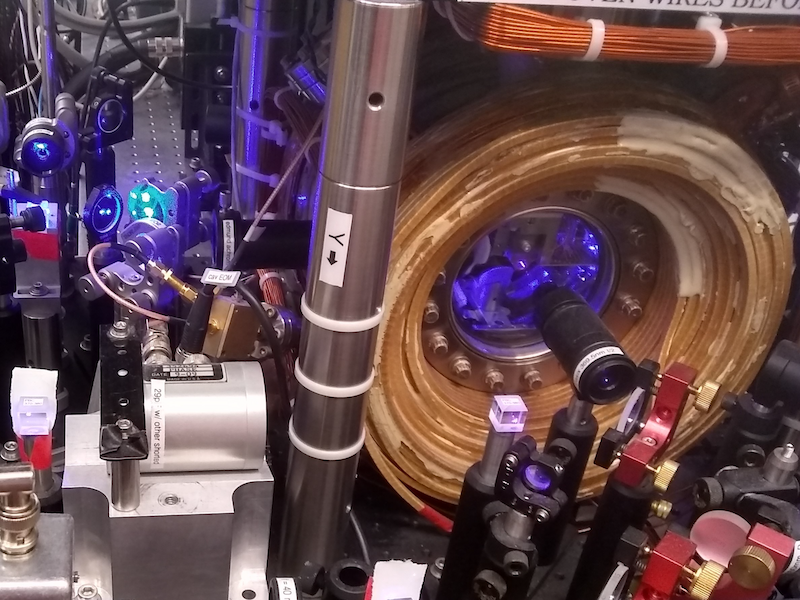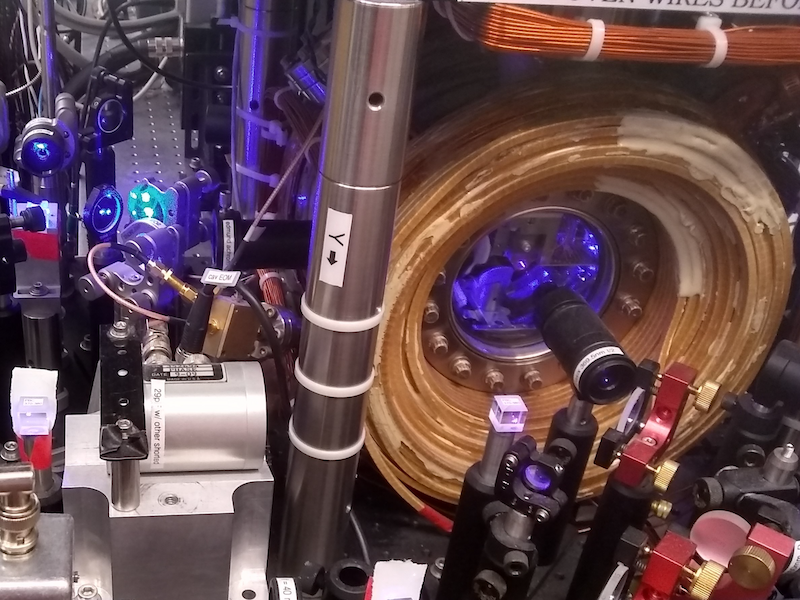Precision Nuclear Probes for New Physics
Traditionally, to discover new fundamental particles, physicists have used colliders, smashing particles at high energies, and looking through their wreckage. But in recent years, low-energy nuclear searches have emerged as a subtler path for particle discovery. Two new studies hint at their potential [1, 2].
The standard model of particle physics describes the fundamental fields of the Universe and their associated particles. But it says nothing about phenomena such as gravity, dark matter, and dark energy—omissions that have led particle physicists to speculate about as-yet-unseen particles.
Isotopes are ideal laboratories for precision nuclear searches of new particles because they have a constant number of protons and electrons. Adding a neutron to create a new isotope only leads to a small, predictable shift in the energy levels of its electronic orbitals—the regions where the electrons reside—and in its g factor—a measure of how strongly the electron bound to an isotope reacts to a magnetic field. A hypothetical particle that couples to neutrons and electrons could create deviations from the predicted values of these parameters.
Tim Sailer, a nuclear physicist at the Max Planck Institute for Nuclear Physics (MPIK), Germany, and colleagues have now developed a method for comparing the g factors of two ions; in this case, two neon isotopes [1]. A different team led by physicist Vladan Vuletić of the Massachusetts Institute of Technology (MIT) has improved their preexisting study of ytterbium’s electron energy levels [2]. Neither study found evidence for a new particle, though the MIT group observed an unexplained deviation of isotope energy levels.
In 1963, University of Oxford physicist William King realized that plotting the energy levels of increasingly heavier isotopes yields a straight line. More recently, physicists proposed that nonlinearities, or kinks, in those so-called King plots could indicate hints of physics beyond the standard model [3]. The MIT group began looking for these kinks in isotopes of ytterbium ions. Two years ago, the group measured the shifted energy levels for two electron configurations in the D state and found evidence for a sizable kink, signaling a discrepancy between their values and the expected straight King plot. But a group at Aarhus University in Denmark working with calcium isotopes saw no such deviation (see Synopsis: Hints of Dark Bosons). The calcium measurement was more precise, but the ytterbium one had better sensitivity to new particles.
Now the MIT group has confirmed the presence of the nonlinearity in ytterbium. By measuring the energy level shift for an F state electron configuration, they improved their sensitivity to nonlinearities 20-fold. Using density-functional theory, MIT team members Paul-Gerhard Reinhard at the University of Erlangen in Germany and Witold Nazarewicz, at Michigan State University calculated the causes of the nonlinearity. They found that most of the King plot deviation resulted from nuclear structure effects. However, nuclear theory could not explain it all, suggesting an unknown second source for the deviation.
The MPIK-led method takes a different route to finding new physics, which Sailer argues is simpler and more direct. For their method, there is no need to find a nonlinearity in a plot. Instead, they just trap two ions with different isotope numbers and directly compare g factors, which they obtain by repeatedly comparing isotope spins. By observing the correlation between the spins, they can spot small frequency differences caused by the additional neutrons. By way of analogy, Sailer says it’s like listening for two instruments with mismatched frequencies and trying to find the beat.
Initially, Sailer and his team worked on calcium isotopes. But after half a year of difficulties (Sailer says restrictions during much of the pandemic limited access to an ion source that was needed) the team switched to neon isotopes, which are much easier to produce. With comparable precision to that of the MIT group, the MPIK group sees no deviations in the measured g factors.
Although the MPIK g-factor-difference measurement has a high precision, the method is currently limited by uncertainties in third-party measurements of properties such as the charge radius of different neon isotopes. And, like the isotope-energy-level measurements, the g-factor method is also vulnerable to nuclear effects that aren’t new physics. “I spend a lot of time worrying about and trying to get rid of the possible influence of these other unwanted effects,” says Vincent Debierre of MPIK, a coauthor on the study. “It’s known physics but in practice, it’s often hard to calculate [its] exact contribution.”
Where these two results leave the possibility of a hypothetical new particle is unclear. The MIT group’s second source of nonlinearity has yet to be corroborated, and there are strong limits on any new particle from both the previous calcium measurements as well as from previous electron g-factor measurements. But those concerns don’t bother other researchers in the field.
“From a theorist’s view, it’s very motivating and rewarding to see that [isotope measurements] caught the interest of experimentalists,” says Elina Fuchs, a theoretical physicist at CERN, Switzerland, not involved with either study. She estimates that around ten groups are currently working on similar isotope searches, up from two or three in 2020—a number that could grow with the g-factor technique. “It is an impressive precision measurement and an interesting alternative method,” Vuletić says. “This new work represents a nice addition to the set of low-energy precision experiments that look for new physics beyond the standard model.”
Fuchs is also excited about data coming out from other groups. In May, a group at Kyoto University in Japan also claimed to see the existence of nonlinearity in their King plot of ytterbium [4]. Both Sailer and Vuletić are confident that they can improve the precision of their respective methods by an order of magnitude over the next few years. To reduce uncertainties, one possible future method might involve a combination of g-factor and energy-level measurements. “In principle, you can become very sensitive to new physics and you can clean up many of the uncertainties,” Debierre says.
(Correction 18 July 2022): The figure credit was updated from Harvard University to MIT, Aude Craik’s current affiliation. The last sentence was corrected to read “…many of the uncertainties” instead of “…all of the uncertainties.”
–Dan Garisto
Dan Garisto is a science journalist based in New York City.
References
- T. Sailer et al., “Measurement of the bound-electron g-factor difference in coupled ions,” Nature 606 (2022).
- J. Hur et al., “Evidence of Two-Source King Plot Nonlinearity in Spectroscopic Search for New Boson,” Phys. Rev. Lett. 128 (2022).
- J. C. Berengut et al., “Probing New Long-Range Interactions by Isotope Shift Spectroscopy,” Phys. Rev. Lett. 120 (2018).
- K. Ono et al., “Observation of Nonlinearity of Generalized King Plot in the Search for New Boson,” Phys. Rev. X 12 (2022).





